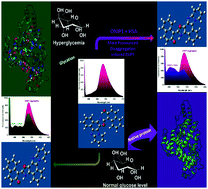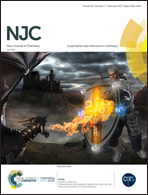Disaggregation-induced ESIPT: a novel approach towards development of sensors for hyperglycemic condition†
Abstract
Hyperglycaemia is a condition of metabolic disorder in which glycation of human serum albumin (HSA) protein occurs. Upon glycation, the α-helical region of the protein undergoes characteristic changes in its structural features. In this study, we designed a fluorescence probe that can distinguish HSA proteins from glycated HSA (GHSA) proteins. The developed probe contains an oxazolonapthoimidazo[1,2-a]pyridine-based moiety (ONIP1) and was designed using rational computational techniques. The compound exhibits aggregation-induced enhanced emission (AIEE) along with the excited-state intermolecular proton transfer (ESIPT) phenomenon. Density functional theory (DFT) calculations have provided data on ground- and excited-state energy-optimized structures and properties of the proposed enol (N*) and keto (T*) form, which is also in agreement with the solution-state experimental findings and supports the occurrence of the ESIPT phenomenon. Using ONIP1, we were able to distinguish HSA and GHSA proteins via typical modulation of AIEE and ESIPT events.



 Please wait while we load your content...
Please wait while we load your content...